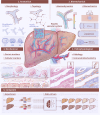Vasomics of the liver
- PMID: 40044498
- PMCID: PMC12229081
- DOI: 10.1136/gutjnl-2024-334133
Vasomics of the liver
Abstract
Chronic liver disease is a cluster of disorders associated with complex haemodynamic alterations, which is characterised by structural and functional disruptions of the intrahepatic and extrahepatic vasculature. 'Vasomics' is an emerging omics discipline that comprehensively analyses and models the vascular system by integrating pathophysiology of disease, biomechanics, medical imaging, computational science and artificial intelligence. Vasomics is further typified by its multidimensional, multiscale and high-throughput nature, which depends on the rapid and robust extraction of well-defined vascular phenotypes with clear clinical and/or biological interpretability. By leveraging multimodality medical imaging techniques, vascular functional assessments, pathological image evaluation, and related computational methods, integrated vasomics provides a deeper understanding of the associations between the vascular system and disease. This in turn reveals the crucial role of the vascular system in disease occurrence, progression and treatment responses, thereby supporting precision medicine approaches. Pathological vascular features have already demonstrated their key role in different clinical scenarios. Despite this, vasomics is yet to be widely recognised. Therefore, we furnished a comprehensive definition of vasomics providing a classification of existing hepatic vascular phenotypes into the following categories: anatomical, biomechanical, biochemical, pathophysiological and composite.
Keywords: CIRRHOSIS; LIVER; PORTAL HYPERTENSION.
© Author(s) (or their employer(s)) 2025. Re-use permitted under CC BY-NC. No commercial re-use. See rights and permissions. Published by BMJ Group.
Conflict of interest statement
Competing interests: None declared.
Figures



References
Publication types
MeSH terms
LinkOut - more resources
Full Text Sources
Medical
